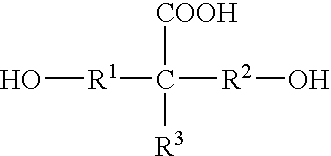Cationically modified, anionic polyurethane dispersions
- Summary
- Abstract
- Description
- Claims
- Application Information
AI Technical Summary
Problems solved by technology
Method used
Image
Examples
Example
Example 1
Dispersion I
[0208] 400 g (0.200 mol) of a polyesterpolyol formed from adipic acid, neopentylglycol and hexanediol and having an OH number of 56 were initially charged to a stirred tank at 50° C. 36.1 g (0.1624 mol) of isophorone diisocyanate, 42.9 g (0.1624 mol) of bis-(4-isocyanatocyclohexyl)methane and 80 g of acetone were added. The mixture was stirred at 90° C. for 60 min before 0.15 g of dibutyltin dilaurate was added. Stirring was continued for a further 120 min. The mixture was then diluted with 500 g of acetone and at the same time cooled to 50° C. The NCO content of the solution was 0.99% (reckoned 0.94%). The addition of 22.5 g (0.0534 mol) of a 50% by weight aqueous solution of the sodium salt of aminoethyl aminoethane sulfonic acid was followed by dispersion in the course of 5 min by addition of 800 g of water. After dispersion, a solution of 3.9 g (0.0379 mol) of diethylenetriamine and 1.8 g (0.0106 mol) of isophoronediamine in 50 g of water was added. The a...
Example
Example 2
Dispersion II
[0209] 400 parts of a propylene glycol having an OH number of 56 were dewatered in a stirred flask at 130° C. and 20 Torr for 30 minutes. The polyether was cooled down, dissolved in 50 parts of N-methylpyrrolidone and admixed with 26.8 parts of dimethylolpropionic acid. This was followed by stirring with 95.7 parts of tolylene diisocyanate (isomer ratio 2.4 / 2.6=80 / 20) at 110° C. for 120 minutes. This was followed by dilution with 400 parts of acetone and cooling to 50° C. 16 parts of triethylamine were added dropwise to the solution thus obtained, followed 10 minutes later by 900 parts of water, added dropwise, before the acetone was distilled off under reduced pressure to leave a very finely divided stable anionic dispersion having a solids content of 40%.
Preparation of Cationically Modified Dispersions III, IV and V
[0210] The following cationic polymers were used: [0211] Polymer 1: polyethyleneimine having a molar mass of 25 000 [0212] Polymer 2: high m...
Example
Example 3
Dispersion III
[0214] 50 g of dispersion I were metered into 50 g of a 0.8% by weight aqueous solution of polymer 1 at room temperature and pH 7 in the course of 10 minutes. The finely divided dispersion obtained was stable for several months.
PUM
| Property | Measurement | Unit |
|---|---|---|
| Fraction | aaaaa | aaaaa |
| Percent by mass | aaaaa | aaaaa |
| Percent by mass | aaaaa | aaaaa |
Abstract
Description
Claims
Application Information
 Login to View More
Login to View More - R&D
- Intellectual Property
- Life Sciences
- Materials
- Tech Scout
- Unparalleled Data Quality
- Higher Quality Content
- 60% Fewer Hallucinations
Browse by: Latest US Patents, China's latest patents, Technical Efficacy Thesaurus, Application Domain, Technology Topic, Popular Technical Reports.
© 2025 PatSnap. All rights reserved.Legal|Privacy policy|Modern Slavery Act Transparency Statement|Sitemap|About US| Contact US: help@patsnap.com



